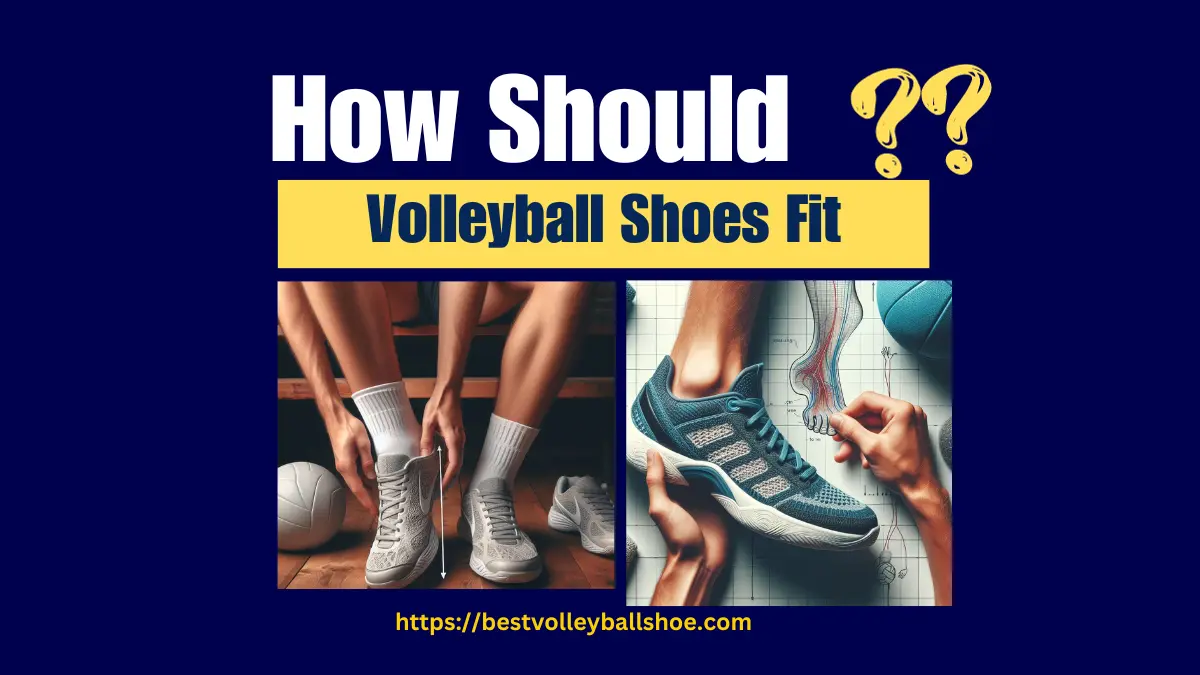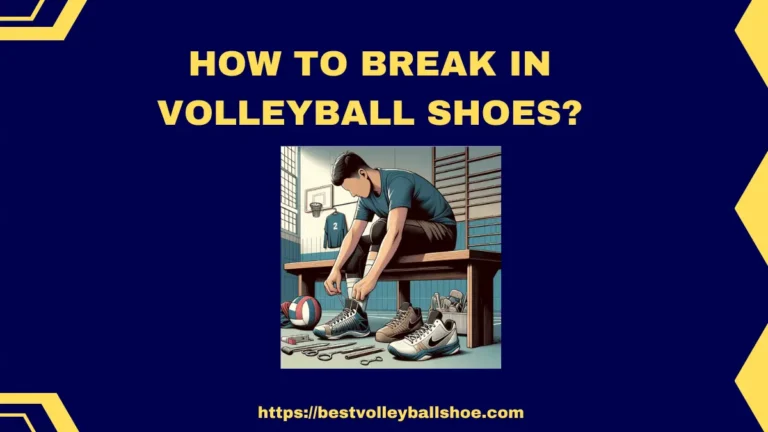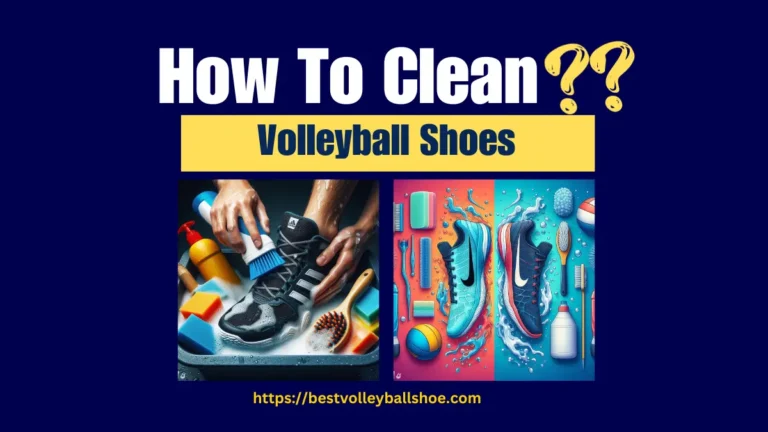How Should Volleyball Shoes Fit

You are on your feet most of the time while playing volleyball. So comfortable and proper fitting of volleyball shoes is pertinent to performance and ease.
A wrong-fitted shoe pair can take you on the track of sustaining blisters, sores, severe injuries like ankle sprains, and deformities like bunions, and hammertoe.
So the question here is which are the right fitted shoes? true to size, either half or a size up/down? The answer is snug and adequately fitted, because too-tight shoes cause discomfort and deformities, while loose-fitting leads to blisters and feet slipping inside the shoes.
Let’s dive into a complete guide covering the various aspects of finding the best fit and How should volleyball shoes fit?
How Should Volleyball Shoes Fit
Here are a few tips and checklists on checking whether your volleyball shoes fit perfectly or not.
Front of the Shoes
Back of the Shoes
To check the back fitting of the shoes you may use the below-mentioned Finger Trick.
Width of the Shoes
Important Considerations for Perfect Fit
Whether you’re buying online or in-store make sure to try the shoes by wearing and walking. Stand Up when you’re trying on shoes because many people make this mistake, they sit on the seat to try the shoes.
When you’re standing up there’s an even distribution of force down to your feet which actually causes your feet to be wider when you’re standing up compared to when you’re sitting down.
Walk around and make sure that the shoe is comfortable and leaves no signs of rub on any part of the foot
Importance of Right Fit & Size of Shoes
I consider the size and fit as preliminary requirements for a good volleyball shoe in addition to traction, comfort, and stability while choosing a volleyball shoe.
Although traction, cushioning, stability, and materials can be a huge difference maker, if the shoe is a misfit I’m sure most of us will just stay away from it.
Importantly, if you choose the wrong shoe size, you are going to join many volleyball athletes around the globe who suffer and complain of foot problems, and the prime culprit behind these problems is improper shoe fitting.
A properly fitted volleyball shoe not only provides comfort and stability but also enhances performance. Here are a few benefits of using the proper fitting of volleyball shoes
Are Volleyball Shoes Supposed to Be Tight or Loose
There is diversity regarding shoe size and fit. Few athletes like the tight fit whereas some opt for the loose fitting.
In my opinion, your volleyball shoes should have a decent balance of fit and comfort i.e. neither too tight to squeeze the foot nor too loose like slippers. Therefore, both too-tight and too-loose shoes should be avoided, instead a snug fit should be opted.
Moreover, the shoe fitting is merely based on personal preferences and choices but wait! You can find your choice below whether you are in a tight fit or a loose fit club.
Why Athletes Choose Tight-Fitting Shoes:
Normally, athletes opt for tight-fit volleyball shoes for the following reasons:
Why Athletes Choose Loose Fitting:
The reasons for choosing the loose fit shoe are as under:
How To Find The Right Size
Choosing the right volleyball shoe size is of paramount importance because of its impact on foot health. The wrongly fitted shoes may lead to foot-related complications like bunions, plantar fasciitis, calluses, corns, stress, and even fractures (Footcare.org).
In order to find the perfect fit one has to consider the following aspects of his foot
Here is how to use the above parameters in finding the right volleyball shoe size.
Measure Your Foot Length and Width
The easiest way to measure your foot size is using a Brannock device. You may buy these devices online or visit any nearby shoe store whether for athletic shoes or formal shoes to measure your foot size. These devices are available in various size markings like US and European sizes.
You may measure your foot with the measuring tape If you don’t have the Brannock device. Measure the heel to toe and then measure the width of the ball of your foot take those numbers and you can move on to the next steps of this process
Things to consider while measuring foot length and width
- Ensure you take measurements at the day’s end when your feet are at their largest. Throughout the day, your feet may swell and settle, so it’s important to prioritize comfort for the entire day rather than just in the morning.
- Avoid relying solely on shoe size: Similar to clothing, the size indicated inside the shoe may vary by brand. Consequently, your shoe size serves as a baseline, and it’s crucial to consider other factors when selecting the right pair.
Do You Know?
The Brannock device was invented in a time when shoes were made to be much more form-fitting much tighter on the person’s foot and they were designed for more leather shoes kind of the dressier shoes.
They weren’t designed for shoes that needed more expansion when you’re sweating and when you’re pounding on them like a court shoe.
Once you find your size on the Barronck device you should
If you should go up a half or a full size usually depends on your foot shape. So lets move further.
You can also measure your foot length and width with the help of measuring tape, here are the simple steps:
Find Your Foot Shape
So now that You’ve partly found foot size it’s time to find your foot shape and for that:-
Based on the shape, the foot may fall in one of the following three categories
How to find the perfect fit from the foot shape
What to do if the shoes are built big or small
Few shoes run small and few are accomodating like as a general Nike shoes are on the snugger side compared to the Mizuno. So in that case i will recommend to
Find Your Foot Arch
Knowing your arch is important as it is related to cushioning and shock absorption. A simple wet test can help determine your foot arch.
Simply immerse your feet in water and step onto the floor or a paper towel. Upon examining your foot imprint, you should identify one of the three prevalent foot types: flat, normal, or high-arched.
Based on the arch type following are the shoe considerations:
How to Find the Right Volleyball Shoe Size Online
if you’re buying online like most people do. What you have to do is just to do the following
Common Shoes Fit Issues
Choosing Too Tight or too-loose shoes
Normally, beginners make mistakes while selecting their desired fit and choose either very tight or very loose kicks. This may be due to the
Here are a few common problems that arise due to wearing too-tight volleyball shoes.
What are the consequences of wearing loose volleyball shoes
How to deal with these issues?
Simply follow the guidelines I have written above regarding how should volleyball shoes fit.
Sizing of Different Shoe Brands (Adidas, Mizuno, Nike & Nike)
Different brands tend to have different types of sizing. So, if your shoe size is 10 of Mizuno then it’s not a guarantee that the same size will be a decent fit in ASICS. The sizing variation could be annoying sometimes. However, this can be dealt with by trying the shoes in person.
Therefore, despite of the expert’s recommendations and experience on shoe sizing and fit, I’ll suggest the best way to ensure the right size is always trying them on in person. Here is my experience regarding the size and fit of different brands.
How Do Mizuno Volleyball Shoes Fit?
Generally, as per my observation, Mizuno shoes accommodate wide feet and are true to size. Here is my opinion regarding the suitability of various Mizuno volleyball shoe models for various foot types.
| Models | Suitability and Fit |
| Mizuno Wave Momentum 1, 2,3 | Wider toe box, Supportive for the wide feet |
| Mizuno Wave Lightning Z6 | Narrow toe box, may run short for wide feet |
| Mizuno Wave Dimension | true to size |
| Mizuno Wave Luminous | true to size for women |
How Do Adidas Volleyball Shoes Fit?
Generally, Adidas volleyball shoes accommodate wide feet. The shoes have a wider toe box that prevents discomfort in the forefoot due to tight fit. However, caution is required while selecting the right size as it may run big leading to a loose fit. Here are my recommendations on the shoe sizing of different Adidas models.
| Model | Suitability and Fit |
| Crazyflight | True to size |
| Ligra 7 | Suitable for wide feet. May runs large for neutral feet |
| Novaflight | Suitable for wide feet. |
| Crazyflight Bounce X 3 | Suitable for wide feet. May run large for neutral feet |
| Dame 8 | Suitable for wide feet. |
How Do Nike Shoes Fit
Overall the Nike volleyball shoes are on the snugger side with a relatively narrower toe box. Here are my recommendations regarding the fit and sizing of different Nike volleyball shoe models
| Models | Suitability and Fit |
| Zoom Hyperace | Snug need to buy half a size bigger |
| Nike Hyperset | Suitable for wide feet, true to size |
How Do Asics Volleyball Shoes fit
Asics volleyball shoes are also diverse regarding shoe sizing. Few models are supportive of the wide feet whereas some have a narrow toe box. Below is the suitability of the most popular Asics volleyball shoe models in terms of fit.
| Shoes | Suitability and Fit |
| Asics Gel Rocket | Narrow toe box and may not fit the wide feet in actual size |
| Asics Upcourt | Narrow-toe box |
| Netburner ballistic | Narrow-toe box |
| Asics Sky Elite FF 2 | Wider toe box, wide feet approved |
| Asics Metarise | Wide feet approved |
Wrapping it Up
Choosing the right fit for volleyball shoes is vital for performance and foot health. In this guide, i have emphasized the key factors such as toe space, heel snugness, and consideration of foot width.
Trying on shoes while standing, walking, and factoring in individual foot characteristics is crucial. Moreover, It is equally important to know the difference between tight and loose-fitting shoes in term of benefits and harms.
However, it is pertinent to find a balance that ensures stability for explosive movements and provides comfort and ventilation. Ultimately, the aim is to achieve a fit that optimizes performance while safeguarding foot well-being.
Frequently Asked Questions
What to do when your volleyball shoes are too tight?
First of all, it is recommended to choose a snug fit i.e. neither too loose nor too tight. However, if you have bought a tight fit, then instead of stretching it better replace it. This is because stretching is not a good practice as it disturbs the overall makeup of the shoes. This may affect the durability and longevity of the shoes and even lead to wear. Other things that you can do are wear thick socks, adjust laces, and use them around in the house.
Do volleyball Shoes Run Small?
Volleyball shoes do not run small instead they fit snugly to support quick movements. Small shoes have the drawback of squeezing the foot and add to an uncomfortable experience. This ultimately affects the performance on the court.
How do I know if my volleyball shoes fit correctly?
Proper volleyball shoes should be snug but not too tight, offer adequate room in the toe box, and not slip at the heel. A good fit ensures maximum support and mobility.
How can I determine if My volleyball shoes fit correctly?
Properly fitting volleyball shoes should feel secure but not overly tight. Your toes should have room to move without the rest of your foot sliding inside the shoe. The heel should stay in place without slipping. It’s important to regularly check the fit, as feet can subtly change shape over time.





